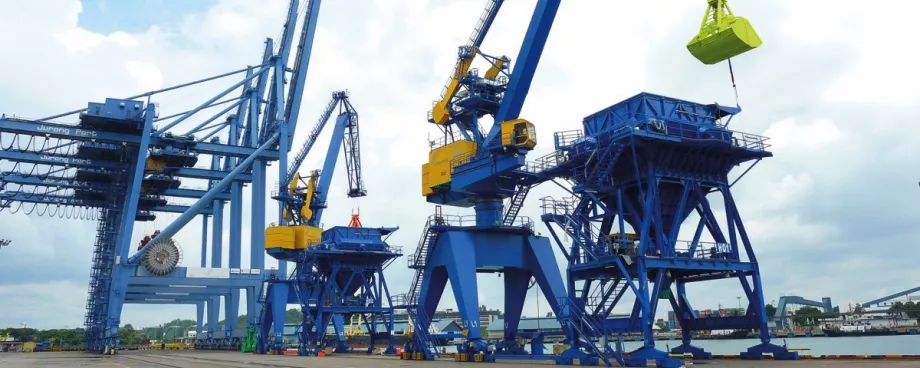In past years the location of minerals process plant was generally governed by the availability of ore and fuel and the market for the finished goods. Particularly in the developed economies, driven by the industrial revolution in Europe, iron and steel products were generally produced close to rich mineral deposits particularly of iron ore and coal. The 19th century saw massive changes e.g. in the Ruhr valley in Germany with a transformation from a mainly agricultural tract of land to a vast iron making and coal mining industrial heartland. Cities such as Dortmund, famous today for their huge industrial complexes, in 1800 had populations of only around 4000.
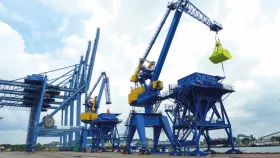
By 1850 the mining industry had grown to employ about 12 000 miners producing some 1.5 million tons of coal. However, during the second half of the century the Ruhr mining companies, and the steel making plants upon which they depended, developed exponentially and by 1910 there were more than 400 000 miners producing some 110 million tons annually of high quality steam and metallurgical quality coal. For both quality and quantity the Ruhr surpassed all others on the European continent.
The Schade company was born into this fury of industrialisation and with two major steel producers in Dortmund at the time, the Dortmunder Union and Hoesch plants, feeding from the vast coal mining complexes there was no shortage of demand for engineering services. At the same time Aumund in Berlin were developing hoisting and conveying concepts targeted at the mining and metallurgical industries and licensing these products for manufacture and sale. In 2001 Aumund acquired Schade and the following year also acquired B&W Mechanical Handling of the UK, now known as Samson Materials Handling Ltd., a small company with general experience in materials handling including products applicable to the mining industry and for loading ships.
The Samson and Schade products are suitable for surface operations and fit well into a modern strip mining concept and together with the products Aumund had developed for the cement industry raw material handling there is a clear synergy in the product programme. This is reinforced with the know-how and product range developed by Samson for ship loading and discharge extending the range of the Aumund Group from the mine to the port and from the port to the processor. The cost of deep mining and the environmental issues surrounding surface mining in highly populated areas forced the European steel plants to look to overseas suppliers for iron ore and coal, making the logistics of moving huge volumes of material a key issue in the development of the market as a whole.
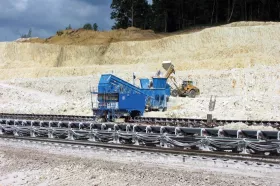
So were born the huge ore terminals in Rotterdam, Amsterdam, Antwerp and other deep water ports where the cargo of Capesize bulk carriers could be discharged and transhipped to small vessels, barges and rail transportation. In parallel to these changes in the Western world further important developments took place in China with its accelerating demand which is effectively controlling the bulk market today. Of course the general minerals market is not just the huge volume areas of iron ore and steam coal but includes dedicated markets for aggregates and specialised minerals such as Gypsum, Bauxite, Olivine, Basalt, Clays, Kaolin, Industrial Sands and much more. Many of these materials are traded in smaller packages suitable for Panamax (65 000 DWT), Handymax (40 000 DWT) down to small bulk carriers and barges of 5000 DWT all of which require loading and discharge facilities.
Industrial minerals are now shipped across the globe in vast volumes demanding efficient logistics to minimise both the cost of transportation and the carbon footprint. The Aumund Group has developed a range of bulk handling solutions at each link in the mineral logistics chain allowing the operator to take maximum advantage of any combination of truck, rail, barge and deep sea shipment.
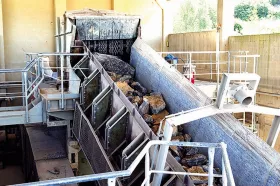
At the mine site the fundamentals of extracting the raw mineral has not changed in centuries, the rock is blasted from the face and loaded to trucks to be taken to a central primary crusher and then conveyed to a secondary crushing and screening station to be stockpiled before export. The apron plate feeder is first in the chain, handling the as-mined lumpy rock, providing a controlled feed rate to the primary crusher with typically an electrical interface to match the feeder to the crusher performance and avoid over-feeding.
The feeder design is based on tracked vehicle type chains and supported on close pitch matching rollers plus central skids to absorb impact loads. Each plate is made in two overlapping parts with milled edges ensuring the plates articulate at the head and tail sprocket and an effective seal maintained to reduce risk of spillage between the plates. Available with a total plate thickness of 80 mm and maximum plate width of 3 metres these machines may be matched to the largest haul trucks for handling rates to 3,000 tons per hour.
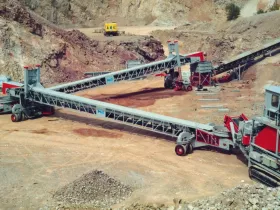
Of course the blast-haul-crush concept with a remote central fixed primary crusher is expensive to operate when the hauling distance increases. One solution is to bring the crusher to the face thus eliminating the intermediate handling by haul truck. Samson pioneered the concept of mobile link conveyors used with a track mounted mobile crusher and hydraulic excavator such that all the equipment operating at the face remained mobile and could be moved back for blasting.
From the link conveyors the sized material may be conveyed on conventional fixed or semi-permanent field conveyor equipment to the secondary crusher and final screening station and stockpile. Whilst the link conveyor solution eliminates all truck haulage there is no doubt that for short distances the flexibility of haul trucks is attractive for the operator.
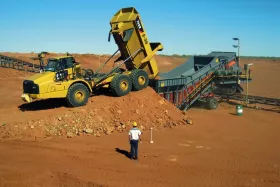
Since the 1970s Samson have evolved their Samson Surface Feeder also into the mining industry finding application as a mobile feed point to receive as-mined rock from articulated dump trucks and deliver to an ongoing belt conveyor incorporating an integral sizer to bring the material down to a manageable size for economic long haul conveying. In this manner of operation the sizer and feeder combination may be moved easily along the length of the conveyor to bring the feed point as close as possible to the work face, blasting permitted. The work face therefore runs parallel to the field conveyor and when the workable length of the field conveyor is exhausted the complete package may be moved sideways on the lateral sledges towards the face again and the process repeated. This is a typical example of blending the best attributes of truck and conveyor haulage to achieve the least operating cost and minimum carbon footprint.










